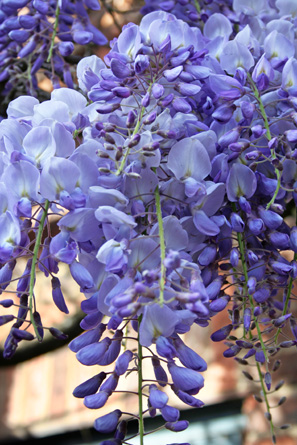
Wildly differing claims have been made on blog posts and photo sharing sites about the age of our magnificent wisteria in Banbury. There is no disputing its magnificence; it is a beautiful specimen with a vast trunk. From the end of April and into the first few weeks of May it becomes Banbury’s top tourist attraction. Right from the moment the glorious long flowers burst into lilac-coloured bloom, visitors start coming up the walk, drawn by the colour and the heady wisteria scent. Cameras, phones and tablets start snapping into action, all trying to capture the wonder of nature climbing up the side of what was once the White Lion Hotel.
Claims about the age of the wisteria have ranged from ‘one hundred years old’ and ‘over two hundred years old’ to, impressively, ‘our five hundred year old wisteria’, as well as just ‘ancient wisteria’. I have been on a quest for the truth to see if I could discover just exactly how old our lovely wisteria really is.
First, a little history of the White Lion. Now no longer a pub or hotel, the White Lion was one of Banbury’s earliest inns, with the first innkeeper being recorded in 1554.1 This makes it older in origin than Banbury’s oldest surviving public house, the Reindeer on Parsons Street. With its large courtyard and outbuildings, together with its position on the High Street, the White Lion was well placed to become one of the main coaching inns in the town. In 1796 the Post Office was recorded as being within the White Lion. William Potts reports that … ‘the post came in every morning about 10 o’clock and the office closed every afternoon at 4 o’clock, the Mail Coach leaving the White Lion daily at 4.30pm through Woodstock and Oxford to the Bull and Mouth, London.’2 By 1836 most of the coach services had been moved to the White Lion3 and the White Lion remained Banbury’s chief coaching inn until rail and motoring developments gradually signalled the end of the coaching era.
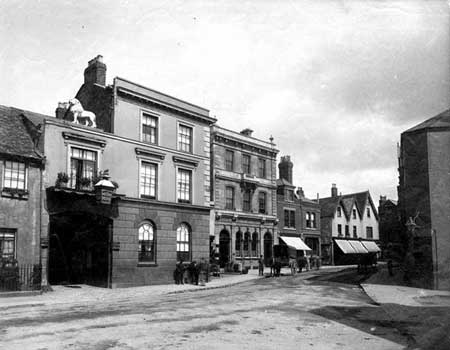
Fuller’s Griffin Brewery in Chiswick claim to have the country’s oldest Wisteria. It is said to have been planted in 1816; one of a pair of saplings brought over from China. One was planted outside what was at the time the Head Brewer’s cottage at the Brewery, while the other was planted at Kew Gardens. The Kew sapling reportedly didn’t take, so the gardeners at Kew returned to the brewery for a cutting, leaving the brewery Wisteria with the acclaim of oldest in the country.4
There is another, better documented, history which deviates from this version though the two versions are not necessarily incompatible.5 It would be interesting to research further the Fuller’s Griffin Brewery account to see where the source of information above has come from.
The other account of the introduction of Wisteria sinensis to the British Isles references the exact same date. Joseph Banks, the then President of the newly founded Royal Horticultural Society6 in London commissioned an East India Company Inspector of Tea, John Reeves, to acquire plants for the society and ship them back to London. Reeves was a natural history enthusiast and collector and during his years in Canton (1812-1831) he collected specimens, commissioned artists’ drawings, documented animals and plants and sent living plant specimens back home.7 Interestingly, in 1821 (and until c. 1903) the RHS rented some land on the Duke of Devonshire’s Chiswick estate to start an experimental specimen garden (hence the possible Chiswick connection with Fuller’s Griffin Brewery).
Reeves sent two plants back to England on two separate ships; one on HCS Cuffnells with Captain Welbank in late 1815 and one a few weeks later, which he accompanied, on HCS Warren Hastings with Captain Rawes. Captain Welbank arrived in England on 4 May 1816 and Captain Rawes and John Reeves arrived with the other plant on 11 May 1816. The plants were transferred to two garden enthusiasts; one to Charles Hampden Turner at Wood Lodge (Eltham) and the other to Thomas Carey Palmer at Vale Cottage (Bromley).8 Charles Hampden Turner’s plant was painted by John Curtis for Curtis’s Botanical Magazine in 1819.9 It had been badly mistreated while Turner and his gardener tried to work out what conditions it would favour but it survived the extreme conditions it was subjected to and must have put out some flowers quite early for it to have been painted in 1819. Palmer gave a propagated plant from his Wisteria to a Hammersmith nurseryman, James Lee, in around 1818 and a flowering specimen was collected from that plant, by Sir James Edward Smith, on 28 May 1821.10 The Wikipedia entry of Charles Hampden Turner claims that Reeves sent another specimen of the same plant to Kew Gardens in 1818 but no citation is provided.11

So, how does this help us with ageing our White Lion Walk Wisteria? It seems highly unlikely that the White Lion would have had an earlier specimen than the ones documented here so we can, with an element of likelihood, say that our Wisteria is no more than 200 years old in 2017. However we cannot ascertain this as a certainty as Vera Wood claimed in 1998 in her book, The Licencees of the Inns, Taverns and Beerhouses of Banbury, that … ‘the wisteria was mentioned well over 240 years ago.’12 Unfortunately, she does not provide a reference for this statement and I have been unable to find any relevant documentation.
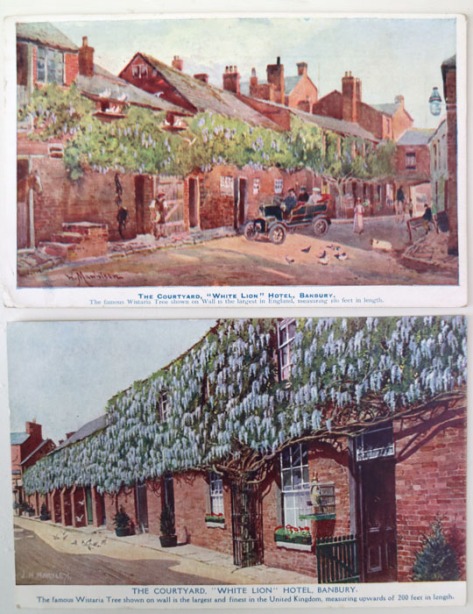
If we assume that our Wisteria is younger than the specimens brought over from China in 1816, then our next difficulty is to try and narrow down the age further. Our Banbury Wisteria has a large trunk and was depicted on postcards in the early twentieth century claiming it as the longest Wisteria in the country. Furthermore, the White Lion was a prestigious coaching inn in the early nineteenth century, with regular links to London and is likely to have attracted some of the more wealthy travelling clientele. The Wisteria could quite feasibly have come from someone travelling through Banbury from the capital; whether an acquaintance, a business association, customer, even ordered up from a nursery due to the reputation of the plant having become established, or given in part payment or thanks for some assistance rendered to a visitor. The size of the Wisteria and the status of the White Lion would suggest that the Banbury plant was an early descendant from one of the 1816 plants. The Wisteria in general became a popular plant across the country quite quickly and by 1854 John Claudius Loudon wrote that … ‘Plants that were originally sold at six guineas, now cost, in the London nurseries, from 1s. 6d. to 2s. 6d. each’.13 This would have been an easily affordable sum for an established coaching inn; therefore with some confidence we can date our Wisteria from c. 1820-1850 at the very latest.
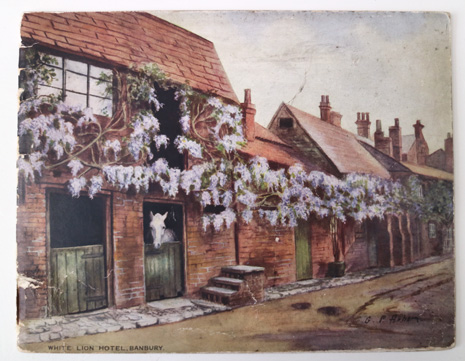
A 1920s advertising booklet for the White Lion Hotel depicts a painting of the Wisteria, by G. P. Hobson [or Hudson?], on the front cover and on page 5 of the booklet it reports snippets from a review of the hotel by The Tatler. In relation to the Wisteria, the article says:
… ‘The tree intrigued me! A wistaria14, it has stuck right down to its job these two hundred odd years, and its branches cover just precisely 68 yards of wall. And the dear old thing has got so old that it has to be looked after by a plumber, who nails chunks of zinc over the spots where it is showing signs of senile decay…’

I’m pleased to report that the Wisteria is now protected by a Tree Preservation Order and is looked after by a firm of arboriculturalists, keeping it trimmed and contained to the one row of buildings along the side of White Lion Walk. Having been shrouded in scaffolding and netting for the latter 8 months of 2016 and having had some utilities-related digging and excavating done around its root system, we are all very relieved to see it uncovered and flowering again with plenty of blooms this spring.
If any readers can provide any further citations or information regarding the White Lion Walk Wisteria I will be very grateful to receive them so please do get in touch if you can help.
Otherwise, do come and visit our Wisteria. White Lion Walk is a gated courtyard so you may find it locked up in the evenings and sometimes on Sundays as well. Best time to visit is during bookshop opening hours!! The fragrance seems to be strongest when the sun warms the blooms, so best time to visit for the fragrance is on a sunny afternoon.
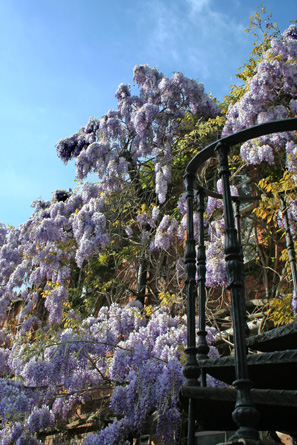
Footnotes
1. Vera Wood, The Licensees of the Inns, Taverns and Beerhouses of Banbury, Oxfordshire (Oxfordshire Family History Society, 1998), p. 128.
2. William Potts, revised and ed. by Edward T. Clark, A History of Banbury (Gulliver Press, Banbury, 2nd ed. 1978), pp. 225-226.
3. Vera Wood, The Licensees of the Inns, Taverns and Beerhouses, p. 130.
4. Fullers Brewery, ‘The Oldest Wisteria in England, 06 May 2015’ https://www.fullers.co.uk/blog/brewery-articles/wisteria (retrieved 25 April 2017).
5. Chiswick connects the Fuller’s Griffin Brewery location and the location of the Royal Horticultural Society garden in London at the same time; neither of which are far from Kew Gardens as well.
6. Wikipedia, ‘The Royal Horticultural Society’ https://en.wikipedia.org/wiki/Royal_Horticultural_Society (retrieved 25 April 2017).
7. Natural History Museum, ‘John Reeves 1774-1856) https://web.archive.org/web/20070322084232/http://www.nhm.ac.uk/nature-online/online-ex/art-themes/drawingconclusions/more/fish_more_info.htm (retrieved 25 April 2017).
8. Culham Research Group, ‘The first Wisteria sinensis in Europe’, March 10 2015 by Alastair Culham; https://blogs.reading.ac.uk/crg/the-first-wisteria-sinensis-in-europe/ ; see also John Claudius Loudon, Arboretum et fructicetum britannicum, or The Trees and Shrubs of Britain, Volume 2’ (Second Edition, Henry Bohn, London, 1854) p. 648, viewed on Google Books https://books.google.co.uk/books?id=IMknAAAAYAAJ&pg=PA648&redir_esc=y#v=onepage&q&f=false (retrieved 25 April 2017).
9. John Sims, Curtis’s Botanical Magazine; or, Flower-Garden Displayed, Volume XLVI (London, 1819), p. 2083, viewed on Biodiversity Heritage Library http://www.biodiversitylibrary.org/item/14330#page/162/mode/1up (retrieved 25 April 2017).
10. Culham Research Group, ‘The first Wisteria sinensis in Europe’.
11. Wikipedia, ‘Charles Turner (merchant)’ https://en.wikipedia.org/wiki/Charles_Turner_(merchant) (retrieved 25 April 2017).
12. Vera Wood, The Licensees of the Inns, Taverns and Beerhouses, p. 130
13. John Sims, Curtis’s Botanical Magazine, p. 2083
14. alternative spelling, used on both White Lion courtyard postcards shown in this article but now no longer commonly used.
Sam Barnes
Books & Ink Bookshop
28 April 2017

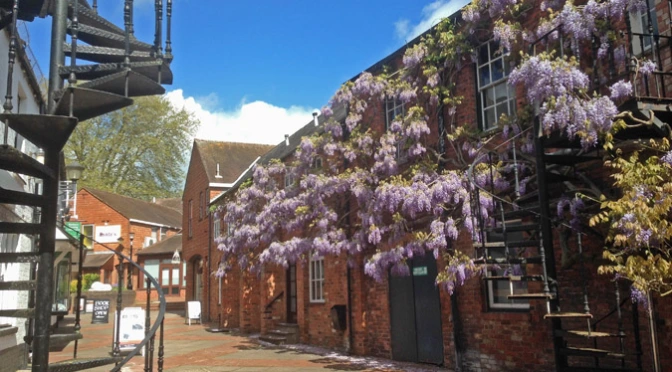
superb
would it not be possible to do a DNA carbon dating without adversely effecting the loverly plant??